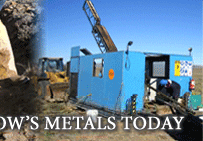Vancouver, B.C., September 28, 2009 -- Argentex Mining Corporation (TSX-V: ATX, OTCBB: AGXM) is pleased to summarize its recently completed mineral resource estimate with highlights from the core diamond drilling completed to date on its Pinguino property in Santa Cruz, Argentina.
Pinguino Resource EstimateIn a recent press release (dated September 14, 2009), Argentex announced the completion of its first-ever National Instrument 43-101-compliant mineral resource estimate for Pinguino, its 100%-owned polymetallic property in Santa Cruz province, Argentina.
At a cutoff grade of 1.6 oz/t silver equivalent, the mineral resource estimate includes:
- 35.4 million tonnes at 4.0 oz/t silver equivalent (inferred category) and
- 7.32 million tonnes at 5.5 oz/t silver equivalent (indicated category)
The silver equivalency calculation combines individual silver, gold, lead, zinc and indium grades at a specific cutoff grade and category into a single "silver equivalent" number. Argentex believes that this provides a simpler representation of the nine individual veins with differing mineralogy used in the recently completed mineral resource estimate at Pinguino. For additional details,
please refer to the September 14, 2009, news release.
Mineralization at Pinguino has a strong geophysical signature from its sulphide-rich mineralization within the vein itself (typically higher-grade material) as well as the wide envelope of disseminated and veinlet mineralization (typically lower-grade material) surrounding the veins. Nine veins of a total of 15 drill tested veins had sufficient density to be used in the mineral resource estimate. More than 47 veins have been mapped to date on the property and numerous geophysical targets remain to be tested.
"Our first mineral resource estimate was a significant milestone in our company's development as it confirms our confidence in Pinguino," said Ken Hicks, President of Argentex. "Furthermore, we have many targets that remain untested and provide excellent exploration potential for new discoveries. We look forward to advancing Pinguino to the next level through a preliminary economic assessment and an aggressive exploration program to commence shortly."
Silver and Gold Highlights"Significant silver and gold drill intersections form part of the body of data that was used to prepare the mineral resource estimate," adds Mr. Hicks. "The surface weathering of the upper portions of the sulphide veins extends to approximately 30 to 50 meters (98 to 164 feet) deep and appears to have created an environment for silver and gold surface enrichment as shown in some of the shallow drilling."
The following table displays highlights from previously released results of core diamond drilling at Pinguino. A map of vein distribution and drill holes at Pinguino is available on our web site:
http://www.argentexmining.com/santacruz-pinguino.php.
*True widths are estimated to be 85-90% of the stated core length
Canadian Institute of Mining ("CIM") definitions were followed for Mineral Resource estimation and classification. As defined, Mineral Resources do not have demonstrated economic viability and Indicated Resources have a higher degree of confidence than do Inferred Resources. The Mineral Resources fall within a volume or shell defined using long term metal price estimates of US $795.45/oz for gold, $13.83/oz for silver, $1.14/lb for zinc, $0.92/lb for lead and spot price of $465 per kilogram for indium.
Silver equivalent calculation uses a 36 month rolling price average. London gold and Silver were determined from the PM price fix in USD. Zinc and lead average prices were calculated from 36 month rolling averages, International Monetary Fund dataset. Indium does not have a world fixed price but trades on the spot market. Indium prices quoted are current spot prices.
The Silver Equivalent (AgEq) calculation is as follows:
AgEq = Ag(g/t) + (Au g/t * 25.57 / 0.44) + (Pb % * 20.282 / 0.44) + (Zn % * 25.132 / 0.44) + (In g/t * 0.465 / 0.44) Indium mineralogy is dominated by solid solution with sphalerite. Indium is recovered in the smelting of zinc concentrates. At this time no metallurgy has been completed on Pinguino, so for the purpose of creating the Silver Equivalent, the study assumed 100% recovery. Actual recoveries will undoubtedly be lower. In addition to presenting the individual metal grades, we have used the Silver Equivalent in an effort to simplify the presentation of all variables in a grade tonnage table that allows for metal zonation and demonstrates the scope of the mineralized system. The most likely cut-off grade for this deposit is not known at this time and must be confirmed by the appropriate economic studies. The estimation of mineral resources may be materially affected by environmental, permitting, legal, title, taxation, sociopolitical, marketing, and other relevant issues.
SI metric units are used as the basis for this study; however Imperial units are sometimes used in the mining industry therefore conversion factors are provided: 31.103481 grams in one troy ounce, one metric tonne = 1000 kilograms = 2204.6 pounds, 1% =22.046 pounds, one meter = 3.28 feet, one hectare = 2.471 acresThe resource estimate was prepared by Gary Giroux, MASc., P.Eng., of Giroux Consultants Ltd ("Giroux"). Robert Morris, P.Geo., of Moose Mountain Technical Services, an independent Qualified Person as defined by Canada's National Instrument 43-101
About PinguinoArgentex's Pinguino property is located in Argentina's Patagonia region, within the Deseado Massif of Santa Cruz province. The 2006 discovery of silver-indium-zinc-lead-gold mineralization at Pinguino marked a major exploration milestone for the company. This was the first discovery of its kind in the region, unique in that it contains both silver-gold and indium-enriched base-metal mineralization. This mineralization is contained in multiple zones that remain open-ended along strike and to depth. Since 2006, exploration of base-metal-rich targets has expanded beyond the initial discoveries at Marta Centro and Yvonne and now encompasses 15 drill-tested veins from more than 47 veins mapped on the property to date. Argentex has drilled a total of 269 holes at Pinguino for a total of 30,028 meters (98,517 feet).
Indium, a significant component of Argentex's polymetallic discovery at Pinguino, is used in flat-panel (LCD, plasma) displays, and in leading-edge thin-film solar cell technology.
Pinguino is easily accessible, situated approximately 400 meters (1,312 feet) above sea level in low-relief topography. An existing system of all-weather roads provides year-round access to the property.
The majority of mineralized zones at Pinguino lie along the strike of the northwest-trending Tranquilo trend, which is a dominant northwest trending regional fault structure cutting the approximately 24,710-acre (10,000-hectare) property.
Quality AssuranceSamples selected for analysis are sent to Acme Analytical Laboratories' sample preparation lab in Mendoza, Argentina. From there sample pulps are sent to Santiago, Chile for fire assay gold analysis and to Vancouver, Canada for Group 1DX multi-element MS-ICP analysis. Samples with over-limit zinc, lead, silver and/or copper are reanalyzed using an ore-grade high detection limit 7AR analysis, also conducted in Vancouver. Acme Analytical Laboratories is an accredited ISO 9000:2001 full-service commercial laboratory with its head office in Vancouver. Referee analyses will be carried out by Alex Stewart (assayers) Argentina S.A. in Mendoza, Argentina. Argentex, Acme and Alex Stewart all maintain comprehensive and independent Quality Control/Quality Assurance programs.
ABOUT ARGENTEX:Argentex Mining Corporation is a Delaware corporation. It is a junior mining company in the exploration stage with significant holdings in the Patagonia region of Argentina. It holds an undivided 100% interest in the mineral rights to the Pinguino property. In total, the company owns 100% mineral rights to more than 35 properties with approximately 307,981 acres (124,636 hectares) of prospective land located in the Santa Cruz and Rio Negro provinces of Argentina. Shares of Argentex common stock trade under the symbol AGXM on the OTCBB and on the TSX Venture Exchange under the symbol ATX.
Exploration on the Pinguino property is being conducted under the supervision of Mr. Kenneth Hicks, P.Geo., Argentex's President and a Qualified Person as defined by Canada's National Instrument 43-101. Mr. Hicks has read and approved the contents of this release and as part of company management, he is not considered independent of the issuer.
Neither TSX Venture Exchange nor its Regulation Services Provider (as that term is defined in the policies of the TSX Venture Exchange) accepts responsibility for the adequacy or accuracy of this release.
FURTHER INFORMATION:Ken Hicks, President
Argentex Mining Corporation
1-866-594-7687
[email protected] Statements in this news release that are not historical facts are forward-looking statements that are subject to risks and uncertainties. Words such as "expects", "intends", "plans", "may", "could", "should", "anticipates", "likely", "believes" and words of similar import also identify forward-looking statements. Forward-looking statements in this news release include statements about the company's belief that untested exploration targets at Pinguino provide excellent exploration potential for new discoveries and that a preliminary economic assessment and an aggressive exploration program can commence shortly. Actual results may differ materially from those currently anticipated due to a number of factors beyond the Company's control. These risks and uncertainties include, among other things, competition for qualified personnel and other risks that are inherent in Argentex's operations including the risk that the Company may not find any minerals in commercially feasible quantity and the Company's ability to raise the capital required to fund a preliminary economic assessment and an aggressive exploration program and otherwise prosecute its exploration plans. These and other risks are described in the Company's Annual Report on Form 10-K and other filings with the Securities and Exchange Commission.
Cautionary note to U.S. investors: The terms "indicated mineral resource", and "inferred mineral resource" used in this news release have been adopted by the Canadian Institute of Mining, Metallurgy and Petroleum Standards on Mineral Resources and Mineral Reserves. Use of these terms in disclosure is recognized and at times required by the Canadian Securities Administrator's National Instrument 43-101, Standards of Disclosure for Mineral Projects ("NI 43-101"), but the Securities and Exchange Commission (the "SEC") does not recognize them and prohibits use of them in documents filed with the SEC. U.S. investors are cautioned that mineral resources that are not mineral "reserves" do not have demonstrated economic viability and there can be no assurance that any part of a mineral deposit included in the measured and indicated categories will ever be converted into a reserve. "Inferred mineral resources" in particular have a great amount of uncertainty as to their economic feasibility. It cannot be assumed that all or any part of an inferred mineral resource will ever be upgraded to a higher category. NI 43-101 provides that estimates of "inferred mineral resources" cannot form the basis of feasibility or other economic studies. U.S. investors are cautioned not to assume that any part or all of an inferred mineral resource exists, or is economically or legally mineable.









